Choose a pot between 6 to 12 inches deep for your indoor ferns, depending on the species. Most varieties thrive in 8-10 inch containers, while compact ferns like Austral Gem Birds Nest need only 6 inches. You'll want plastic or glazed ceramic pots with proper drainage holes to prevent root rot. Keep an eye on roots emerging from drainage holes, as this signals it's time to size up. Our detailed guide will help you master the perfect pot depth for your specific fern.
Understanding Optimal Pot Depths for Different Fern Species
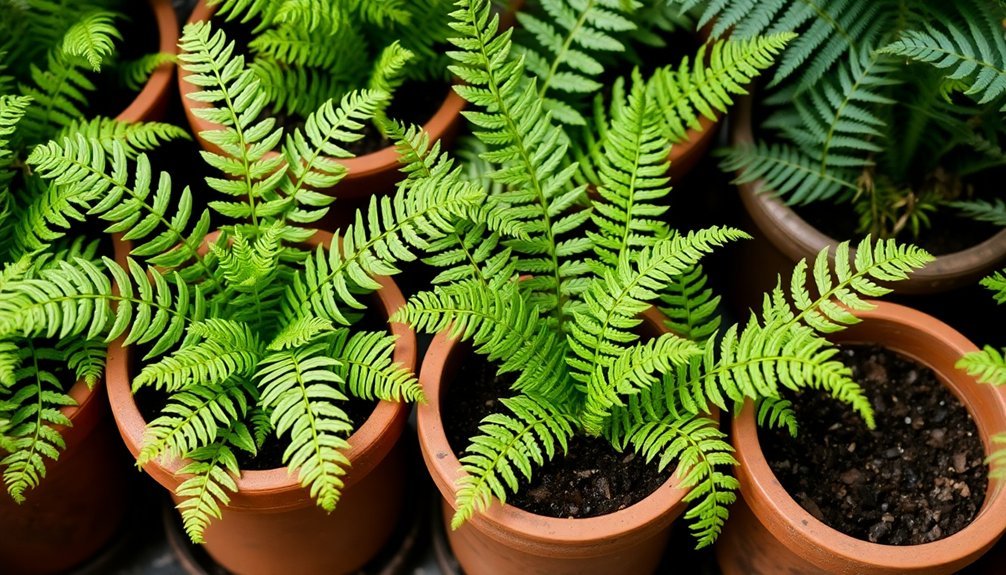
When choosing pots for indoor ferns, you'll need to match the container depth to your specific species' root requirements.
For best pot depth, consider that Boston Ferns thrive in containers 8 to 10 inches deep, while compact ferns like the Austral Gem Birds Nest only need about 6 inches.
If you're growing Lacy Rabbits Foot Ferns, opt for shallow containers that accommodate their spreading growth pattern.
For ferns with rhizomes, such as the Japanese Holly Fern, ascertain your pot is 6 to 8 inches deep to support healthy root development and proper moisture retention.
Measuring Root Space Requirements for Indoor Ferns
To properly assess your fern's root space needs, start by examining its root ball growth pattern, which typically spreads horizontally rather than vertically.
You'll want to select a container that's 8-10 inches deep for most indoor ferns, though you can opt for a 6-inch depth with smaller varieties or up to 12 inches for larger species.
While shallow pots can work for spreading roots, deeper containers offer better stability and moisture regulation, provided you've included proper drainage holes to prevent waterlogging.
Root Ball Growth Patterns
Understanding your fern's root ball growth pattern is essential for selecting the right pot depth and maintaining healthy plants.
You'll notice that ferns develop shallow root systems that spread horizontally, typically requiring pots between 6 to 12 inches deep for ideal growth.
Watch for signs that your fern needs more space – if roots emerge from drainage holes, it's time to repot.
When selecting a new container, choose one that's at least 2 inches deeper than the current pot to accommodate healthy growth.
Boston Ferns can develop root balls up to 12 inches wide, so they'll need adequate lateral space along with proper depth.
For smaller varieties like the American Maidenhair Fern, an 8-inch pot depth usually provides sufficient room for growth and moisture retention.
Regular monitoring of root development helps prevent your fern from becoming root-bound.
Container Size Selection Guidelines
Selecting the right container size for your indoor fern starts with measuring its current root space requirements.
You'll want to choose a pot depth between 6 to 12 inches to guarantee proper root development and prevent root binding. Most indoor ferns thrive in shallow containers, with 6 to 8 inches being ideal for best moisture retention.
When choosing your container size, make certain it has adequate drainage holes to avoid waterlogging.
If you notice roots emerging from these holes or circling the pot's edges, it's time to repot into a container one size larger.
Consider your specific fern variety – compact species do well in narrower pots, while larger ferns need deeper containers for healthy root expansion.
This careful selection will support your fern's growth and maintain its overall health.
Shallow Vs Deep Benefits
The key distinction between shallow and deep pots directly impacts your indoor fern's health and growth potential. Shallow pots support your fern's natural root systems, which spread horizontally rather than vertically, providing adequate surface area for ideal growth.
| Feature | Shallow Pots | Deep Pots |
|---|---|---|
| Root Growth | Promotes natural horizontal spread | Forces unnatural vertical growth |
| Water Management | Efficient drainage | Risk of water accumulation |
| Aeration | Better oxygen flow to roots | Limited air circulation |
| Disease Risk | Lower chance of root rot | Higher risk of root problems |
| Maintenance | Easier to monitor soil moisture | Difficult to assess bottom moisture |
You'll find that shallow containers, typically 6-8 inches deep, provide better aeration and drainage while preventing overwatering issues. This design matches your fern's natural growing patterns and helps avoid the common problems associated with excess moisture retention that often occur in deeper containers.
Selecting Container Sizes Based on Fern Maturity
You'll find that young ferns thrive in containers 4 to 6 inches deep, which provides the perfect balance of root space without excess soil.
As your fern matures, shift to deeper pots of 8 to 12 inches when roots begin showing through drainage holes.
For larger specimens, choose containers 12 to 18 inches deep to guarantee proper stability and healthy root development.
Growing Ferns Need Space
Proper container sizing is crucial for fern health at every growth stage. As your fern develops, you'll need to take into account both pot depth and width to accommodate root expansion. Most mature ferns thrive in containers 6 to 12 inches deep, while smaller varieties do well in shallow pots of 4 to 6 inches.
Watch for signs that your fern needs repotting, especially when roots emerge from drainage holes. When this happens, your plant's becoming root-bound and requires a larger container.
Choose a pot that's slightly wider than the current one to support lateral root growth and maintain proper moisture levels. Remember that regardless of size, your container must have adequate drainage holes to prevent waterlogging.
This careful attention to pot sizing will help guarantee your fern's continued growth and health.
Shallow Containers For Stability
Shallow containers provide perfect stability for indoor ferns while promoting healthy root development.
You'll want to choose pots that are 6 to 8 inches deep for mature ferns, as their roots naturally spread horizontally rather than vertically.
When repotting your fern, select a container diameter that's just 1 to 2 inches larger than the current root ball. This guarantees your plant has enough space to grow without being overwhelmed.
Shallow pots are particularly effective at maintaining consistent moisture levels throughout the soil, which helps prevent root rot. You'll find that these containers allow the soil to dry more evenly, creating ideal conditions for healthy development.
Essential Drainage Features for Fern Containers
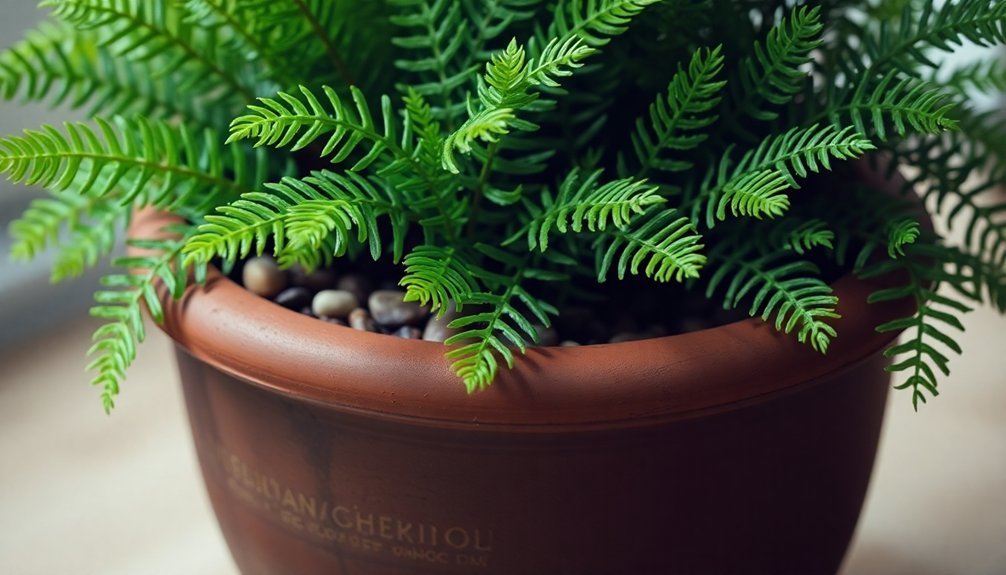
Three critical drainage features make the difference between thriving indoor ferns and those that struggle with root problems.
First, you'll need proper drainage holes at the bottom of your containers to prevent root rot and waterlogging. These holes allow excess water to escape while maintaining healthy soil aeration.
Second, add a layer of gravel at the container's base to enhance drainage and create better air circulation throughout the pot. This simple addition helps protect your fern's roots from sitting in soggy soil.
Finally, choose containers made from materials like plastic or clay that balance moisture retention with proper drainage.
Remember to check your pot's drainage features regularly to verify they're not blocked. Maintaining these essential elements will create healthy plant conditions that support your fern's growth and prevent common moisture-related issues.
Shallow Vs Deep Pots: Impact on Fern Health
When choosing between shallow and deep pots for your indoor ferns, you'll find that shallower containers around 6-8 inches deep better accommodate their natural spreading root systems.
You'll notice that deeper pots can trap excess moisture and create waterlogged conditions that may lead to root rot, while shallow pots promote better drainage and air circulation throughout the root zone.
Your fern's roots will thrive in a pot that matches their horizontal growth pattern, allowing them to spread naturally while maintaining ideal moisture levels.
Root Growth Vs Depth
The choice between shallow and deep pots can greatly impact your indoor fern's health and growth patterns. You'll want to focus on shallow pots (4-8 inches deep) to support your fern's natural horizontal root systems. This allows ideal access to moisture and nutrients while preventing excess soil moisture that can lead to root rot.
| Shallow Pots (4-8") | Deep Pots (>8") |
|---|---|
| Better drainage | Poor drainage |
| Proper aeration | Water retention |
| Horizontal growth | Root rot risk |
| Easy repotting | Wasted space |
When repotting your fern, choose a container that's just slightly larger than its current home. This strategy promotes healthy root growth by allowing roots to spread horizontally while maintaining proper drainage. Remember, your fern's roots don't need extensive vertical space – they'll thrive in shallower environments that mirror their natural growing conditions.
Drainage Impact By Height
Proper drainage emerges as a key difference between shallow and deep pots for indoor ferns.
In shallow pots, you'll find that excess moisture drains more efficiently, greatly reducing the risk of root rot and promoting healthy growth. The ideal pot depth of 6-8 inches creates ideal conditions for your ferns by preventing water from pooling around their roots.
When you use deeper pots, you're more likely to encounter drainage issues because the additional soil retains more moisture than your fern needs. This excess moisture can quickly lead to waterlogged conditions, compromising fern health and root development.
Since most indoor ferns naturally have shallow root systems, they'll thrive better in containers that match their growth habits and allow water to escape easily through proper drainage channels.
Root Development Patterns in Container-Grown Ferns

Understanding how fern roots develop in containers is essential for successful indoor growing. You'll find that most container-grown ferns develop shallow root systems that spread laterally, requiring pots with adequate width and depth to support healthy root development.
When choosing a pot depth, aim for 8 to 12 inches to provide your fern with sufficient space while maintaining proper moisture levels.
You'll want to monitor your fern's growth by checking the drainage holes for protruding roots, which signal it's becoming root-bound. During repotting, select a container that's just slightly larger than the current one to encourage ideal health without risking excessive soil moisture.
Remember that proper pot depth directly impacts your fern's ability to establish a strong root system and thrive in its container environment.
Adjusting Pot Depth for Various Growing Environments
Successfully growing ferns indoors requires matching pot depths to your specific growing environment.
You'll need to take into account factors like humidity, light exposure, and temperature when selecting the right container depth for ideal root development.
For rooms with lower humidity, choose deeper pots (10-12 inches) to help maintain consistent moisture levels.
In humid spaces, you can opt for shallow pots around 6 inches deep, especially for varieties like Japanese Painted Ferns.
If you're growing ferns in bright, indirect light, guarantee proper drainage with 8-10 inch pots for rhizome-spreading varieties.
When repotting ferns, increase pot depth gradually by just 1-2 inches to prevent waterlogging.
Remember that soil support needs vary – larger varieties like Boston Ferns thrive in deeper containers, while compact species prefer less depth.
Signs Your Fern Needs a Different Pot Depth
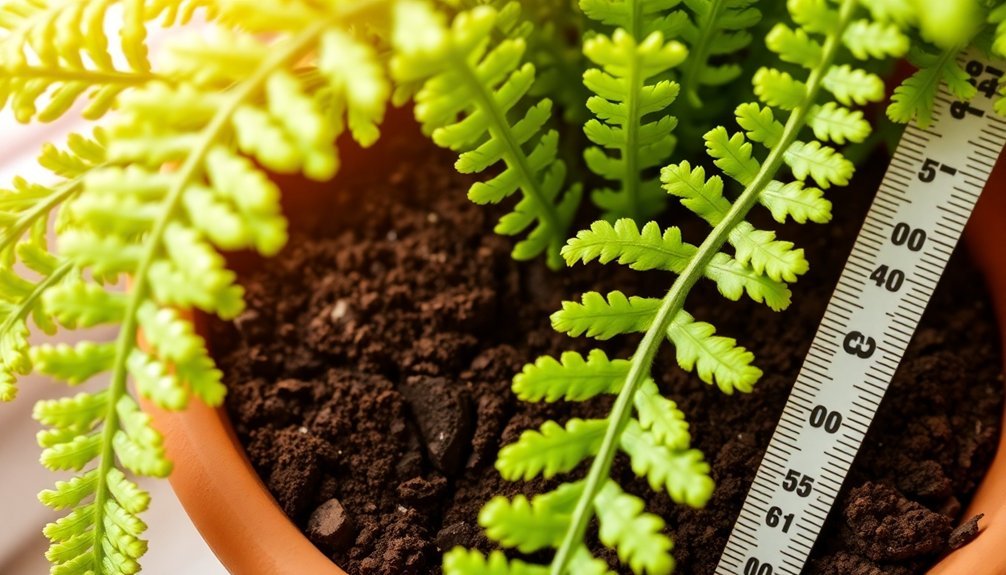
Your fern will tell you when it needs a different pot depth through several clear warning signs. When roots emerge from drainage holes, it's a clear indicator your plant is root-bound and requires a deeper container.
Watch for changes in your fern's behavior that signal insufficient pot depth:
- Slow growth and yellowing fronds, despite proper care, indicate the roots can't access enough nutrients and water.
- Quick water drainage and poor moisture retention suggest your pot is too shallow to maintain adequate hydration.
- A top-heavy appearance or unstable plant signals the need for a deeper pot to provide adequate support.
Don't ignore these signs – they're your fern's way of communicating that it needs more room to thrive.
Responding promptly will help maintain your plant's health and vigor.
Balancing Moisture Retention With Root Aeration
The delicate balance between moisture retention and root aeration stands as a critical factor in fern health.
You'll need to select the right pot depth to achieve this balance, choosing between 6 to 12 inches depending on your fern's root system.
To maintain ideal moisture retention while preventing root rot, verify your pot has adequate drainage holes and use a well-draining potting mix.
If you've chosen a deeper pot, you'll need to monitor soil moisture more carefully, as these containers hold water longer.
For shallower root systems, a 6-inch pot depth provides sufficient aeration while maintaining appropriate moisture levels.
You can protect your fern's root growth by avoiding waterlogged conditions.
Remember that proper aeration is just as important as moisture retention – both elements work together to support your fern's health.
Container Materials and Their Effect on Root Growth
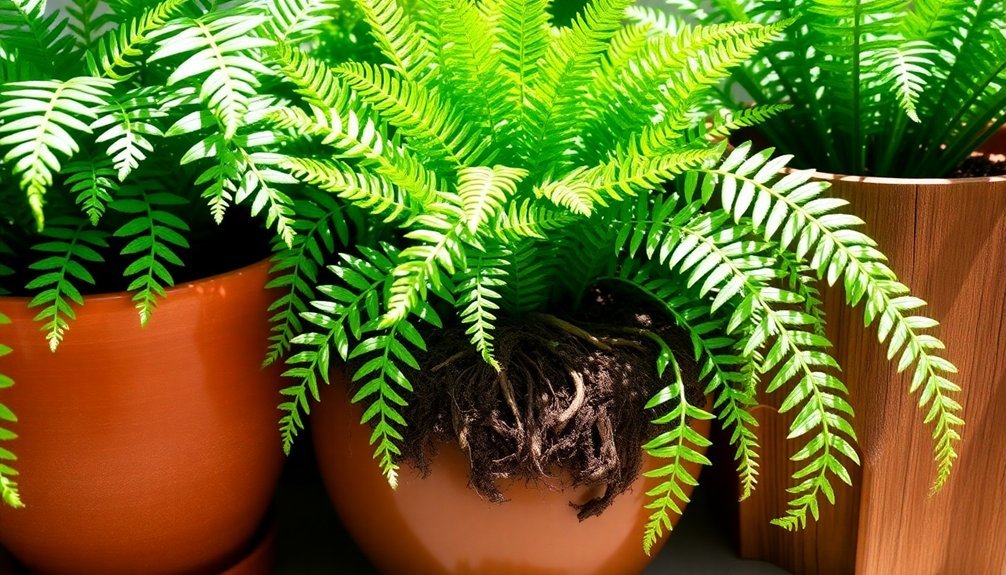
When growing indoor ferns, pot material directly impacts root development and overall plant health. Each material offers distinct benefits that affect your plant's root growth and moisture balance.
1. Plastic pots offer excellent moisture retention and lightweight handling, making them ideal for indoor ferns that need consistent dampness.
Just make sure they've adequate drainage holes to prevent root rot.
2. Terracotta pots provide superior airflow and natural moisture regulation through their porous structure, but you'll need to water more frequently to maintain ideal conditions for root growth.
3. Glazed ceramic containers strike a balance between moisture retention and breathability, perfect for maintaining stable growing conditions.
Remember that regardless of material choice, proper pot depth of 8-10 inches is essential for healthy root development.
Your container should always include sufficient drainage holes to protect against waterlogging and root rot.
Seasonal Changes in Pot Depth Requirements
Just as nature adapts to changing seasons, indoor ferns require different pot depths throughout the year to maintain ideal growth.
During spring and summer's active growth phase, you'll need pots that are 8 to 10 inches deep to accommodate expanding root systems. However, when fall and winter arrive, you can switch to shallower 6 to 8-inch pots as your fern's growth slows down.
Watch for signs that your fern's becoming root-bound, and when it does, repot them in a container that's 2 inches deeper than the current one.
Keep in mind that seasonal temperature changes affect moisture retention – deeper pots in warmer months support rapid growth, but they can hold excess water.
Ascertain proper drainage year-round, as too much moisture can lead to root problems, especially during less active growing periods.
Maximizing Growth Potential Through Proper Sizing
Building on seasonal considerations, proper pot sizing plays a direct role in maximizing your fern's growth potential.
To guarantee healthy indoor ferns, you'll want to select containers that provide ideal space for root systems while maintaining adequate drainage.
For maximum growth potential, follow these key guidelines:
- Choose pots 8-12 inches deep for most ferns, allowing roots to spread naturally without risking overcrowding.
- Select deeper pots (10-14 inches) for larger fern varieties to accommodate their extensive root systems.
- When repotting, increase pot depth by only 1-2 inches to promote steady growth without overwhelming the plant.
Remember that pot depth directly impacts your fern's development – too shallow, and you'll restrict root growth; too deep, and you risk poor moisture management.
Finding the right balance guarantees your ferns thrive in their indoor environment.
Frequently Asked Questions
How Deep of a Pot Do Ferns Need?
You'll want to grow your ferns in pots that are 6 to 12 inches deep, with 8 to 10 inches being ideal. This depth gives their shallow roots enough space while preventing waterlogging issues.
Do Ferns Like Big Pots or Small Pots?
You'll want to keep your ferns in smaller, snug pots rather than large ones. They actually thrive when slightly root-bound, and oversized pots can lead to moisture problems that'll harm your plant's health.
What Is the Ideal Pot for Fern?
You'll want a shallow pot (6-12 inches deep) with drainage holes. Choose plastic or clay, and don't go too big – just one size up when repotting. Make certain there's room for horizontal root spread.
Where Is the Best Place to Put Ferns Indoors?
Place your ferns near north or east-facing windows for bright, indirect light. You'll want to keep them away from heating vents and group them with other plants to maintain humidity levels of 40-50%.
In Summary
Choose your fern's pot depth carefully – it's essential for healthy growth and root development. You'll want to provide 4-6 inches for most small varieties and 8-12 inches for larger species. Remember, proper drainage and pot material matter just as much as depth. When you're repotting, go up just one size to avoid overwatering issues. Monitor your fern's growth and adjust container depth seasonally for best results.

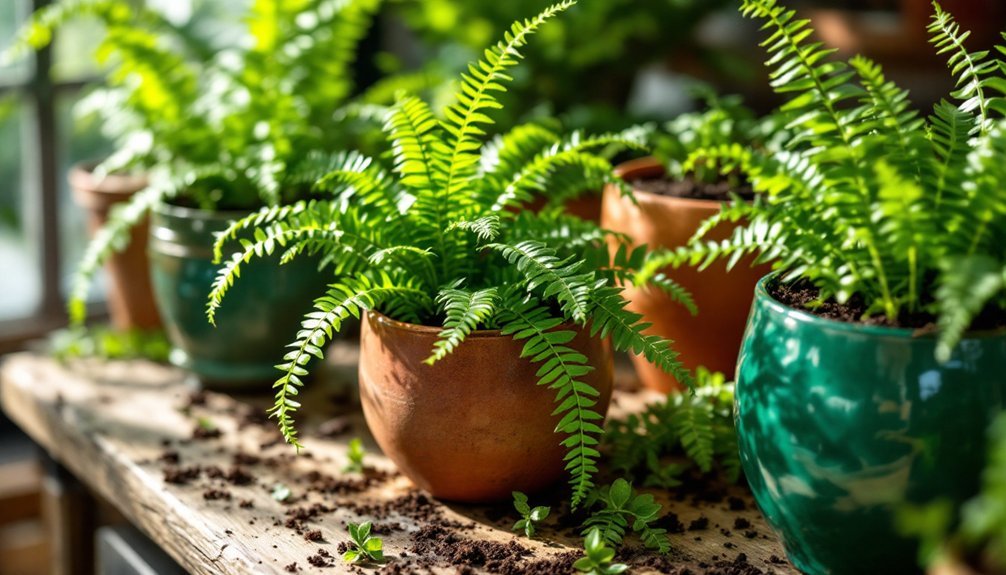



Leave a Reply